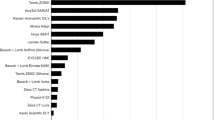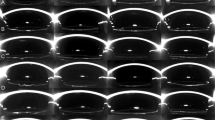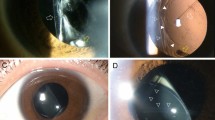Abstract
Purpose
To compare the outcomes of phacoemulsification with either a 2.5-mm clear corneal incision and a foldable intraocular lens (IOL) or a 5-mm sclerocorneal tunnel incision and a rigid polymethyl methacrylate (PMMA) IOL.
Methods
In a prospective, randomised clinical trial of phacoemulsification cataract surgery, 1200 patients received either a foldable hydrophilic acrylic IOL through a 2.5-mm corneal incision or an inexpensive rigid PMMA IOL via a 5-mm sclerocorneal tunnel. Intra- and post-operative data and visual acuity at discharge, 6 weeks, and 1 year follow-up were analysed.
Results
At 1 year after surgery, 996 (83.0%) patients were followed up with an uncorrected visual acuity of 6/18 or better in 90.3% of the foldable and 94.3% in the rigid IOL group (risk ratio (RR) 0.96, 95% confidence intervals (CI) 0.92–0.99). Poor outcome (best-corrected acuity 6/60 or worse) occurred in 1.0% and 0.4%, respectively (RR 4.28, 95% CI 0.48–38.18). The surgical cost of consumables and overall surgical time were similar in both groups; however, the cost of the foldable IOL was eight times higher than the PMMA IOL. Posterior capsule opacification was more common in the rigid IOL group at 12 months (36.1% vs 23.3%); however, this did not affect post-operative vision.
Conclusion
In the hands of experienced cataract surgeons, phacoemulsification with implantation of a foldable or a rigid IOL gives excellent results. Using an inexpensive rigid PMMA IOL will make phacoemulsification more affordable for poor patients in low- and middle-income countries.
Similar content being viewed by others
Log in or create a free account to read this content
Gain free access to this article, as well as selected content from this journal and more on nature.com
or
References
Pascolini D, Mariotti SP . Global estimates of visual impairment: 2010. Br J Ophthalmol 2012; 96 (5): 614–618.
Lindfield R, Vishwanath K, Ngounou F, Khanna RC . The challenges in improving outcome of cataract surgery in low and middle income countries. Indian J Ophthalmol 2012; 60 (5): 464–469.
Polack S, Yorston D, Lopez-Ramos A, Lepe-Orta S, Baia RM, Alves L et al. Rapid assessment of avoidable blindness and diabetic retinopathy in Chiapas, Mexico. Ophthalmology 2012; 119 (5): 1033–1040.
Lindfield R, Griffiths U, Bozzani F, Mumba M, Munsanje J . A rapid assessment of avoidable blindness in Southern Zambia. PLoS One 2012; 7 (6): e38483.
Al Ghamdi AH, Rabiu M, Hajar S, Yorston D, Kuper H, Polack S . Rapid assessment of avoidable blindness and diabetic retinopathy in Taif, Saudi Arabia. Br J Ophthalmol 2012; 96 (9): 1168–1172.
Riaz Y, Mehta JS, Wormald R, Evans JR, Foster A, Ravilla T et al. Surgical interventions for age-related cataract. Cochrane Database Syst Rev 2006; (4): CD001323 doi:10.1002/14651858.CD001323.pub2.
Gogate PM, Kulkarni SR, Krishnaiah S, Deshpande RD, Joshi SA, Palimkar A et al. Safety and efficacy of phacoemulsification compared with manual small-incision cataract surgery by a randomized controlled clinical trial: six-week results. Ophthalmology 2005; 112 (5): 869–874.
Cook C, Carrara H, Myer L . Phaco-emulsification versus manual small-incision cataract surgery in South Africa. S Afr Med J 2012; 102 (6): 537–540.
Ruit S, Tabin G, Chang D, Bajracharya L, Kline DC, Richheimer W et al. A prospective randomized clinical trial of phacoemulsification vs manual sutureless small-incision extracapsular cataract surgery in Nepal. Am J Ophthalmol 2007; 143 (1): 32–38.
Venkatesh R, Tan CS, Sengupta S, Ravindran RD, Krishnan KT, Chang DF . Phacoemulsification versus manual small-incision cataract surgery for white cataract. J Cataract Refract Surg 2010; 36 (11): 1849–1854.
Riaz Y, de Silva SR, Evans JR . Manual small incision cataract surgery (MSICS) with posterior chamber intraocular lens versus phacoemulsification with posterior chamber intraocular lens for age-related cataract. Cochrane Database Syst Rev 2013; 10: CD008813.
Gogate P, Deshpande M, Nirmalan PK . Why do phacoemulsification? Manual small-incision cataract surgery is almost as effective, but less expensive. Ophthalmology 2007; 114 (5): 965–968.
Hennig A, Singh S, Winter I, Yorston D . Can phaco be a cost-effective solution to cataract blindness? Costs and outcomes in Nepal. Eye (Lond) 2010; 24 (6): 1104.
Bland JM . The tyranny of power: is there a better way to calculate sample size? BMJ 2009; 339, doi: 10.1136/bmj.b3985 b3985.
Cheng JW, Wei RL, Cai JP, Xi GL, Zhu H, Li Y et al. Efficacy of different intraocular lens materials and optic edge designs in preventing posterior capsular opacification: a meta-analysis. Am J Ophthalmol 2007; 143 (3): 428–436.
Peng Q, Hennig A, Vasavada AR, Apple DJ . Posterior capsular plaque: a common feature of cataract surgery in the developing world. Am J Ophthalmol 1998; 125 (5): 621–626.
Daniel C, Tuft S, Ionides A, Bunce C . Effect of visual acuity on biometry prediction error after cataract surgery. J Cataract Refract Surg 2003; 29 (7): 1365–1369.
Koch Paul S . Structural analysis of cataract incision construction. J Cataract Refract Surg 1991; 17 (Suppl): 661–667.
Fine IH, Hoffman RS, Packer M . Incision construction. In: Steinert RF (ed). Cataract Surgery. WB Saunders, Elsevier: Philadelphia, 2010 pp 141–162.
Acknowledgements
We thank the SCEH team, in particular Sudhir Thakur, for managing patient follow-up and data entry, and Ganesh Prasad Upadhyay, Chandra Narayan Choudhary, and Mahendra Mahato for assisting study patients during hospital stay.
Author information
Authors and Affiliations
Corresponding author
Ethics declarations
Competing interests
The authors declare no conflict of interest.
Rights and permissions
About this article
Cite this article
Hennig, A., Puri, L., Sharma, H. et al. Foldable vs rigid lenses after phacoemulsification for cataract surgery: a randomised controlled trial. Eye 28, 567–575 (2014). https://doi.org/10.1038/eye.2014.26
Received:
Accepted:
Published:
Issue date:
DOI: https://doi.org/10.1038/eye.2014.26
Keywords
This article is cited by
-
Phacoemulsification Cataract Surgery Affects the Discriminative Capacity of Iris Pattern Recognition
Scientific Reports (2019)



